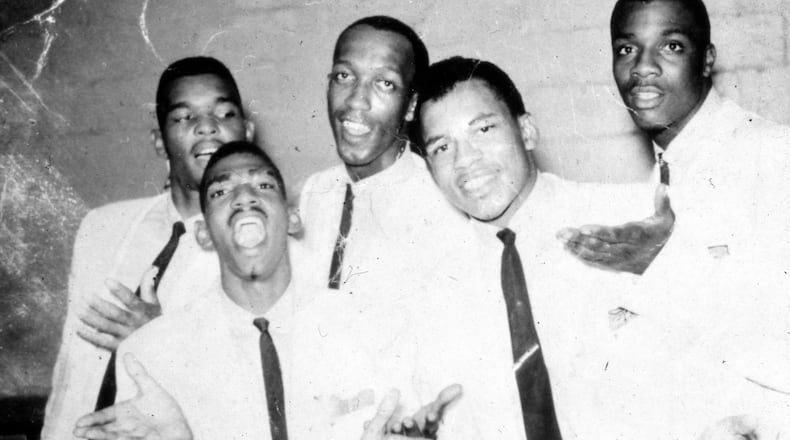“It was a unique experience,” Davis said. “It was one of those doo-wop things. We started in my living room in East Dayton. It was only a four-room house, but Mom let us use the living room to rehearse. It was a good experience. We started it just to have fun. It seemed like there were groups all over the city. I really enjoyed it.”
The El Vireos’ history is mostly forgotten but it’s notable, before integration, the local act featured five black singers and a trio of white backing musicians. Davis (baritone) and vocalists Frank Williams (lead singer), Charles Hill (bass), LeVoy Fredericks (second tenor) and Sonny Jackson (first tenor) were backed by Denny Davis (saxophone), Jim Jennings (guitar) and Bob Hensley (drums). Like Davis, most of the El Vireos were students at Wilbur Wright High School in East Dayton. However, one singer attended Stebbins and another went to Dunbar.
“We’d sing on various stages and go to talent shows at different high schools and just have fun,” Davis said. “We performed at churches. Community centers and recreational centers always had talent shows. You always had these different nurturing things for young people.”
Integrated band
While mix-raced groups were uncommon at the time, Davis said it wasn’t strange considering Wilbur Wright was integrated when he got there in the mid-1950s.
“As quiet as it was kept, even in the ’30s and ’40s, there were always a few black students from East Dayton that attended Wilbur Wright,” Davis said. “A couple of them may have even gone to Stivers, which was also in East Dayton. It was unspoken, unwritten, but if you were black, you could go to the school in your neighborhood or you could go to Roosevelt or Dunbar.
“There were always some African Americans who took the multiple-bus trip across town to Dunbar and Roosevelt, but there was always some integration taking place,” Davis continued.
Despite being very much in the minority, Davis doesn’t recall dealing with much outright racism going to school in East Dayton.
“No more than the usual problems,” he said. “You’d have those situations where some teachers were racist and there were others who just wanted to do a good job and teach you. The African American community in East Dayton was small. It was only four streets. There were five blacks in my graduating class in high school and most of us involved ourselves in a variety of extracurricular activities. For me, it was sports and art and it didn’t matter what the (racial) makeup was.”
School daze
While Davis was an all-city basketball player at Wilbur Wright, he didn’t get any sports scholarship offers. He ended up attending DePauw University in Greencastle, Ind., on a scholarship for students of Appalachian descent.
“We were getting serious as I went off to college to study art and play basketball,” Davis said “We tried to keep it together as best we could during those years I was in college, although it wasn’t really as serious as before. The group was hanging on by a thread of visits home and group visits to campus to perform at frat and sorority parties.”
And like something out of a Hollywood drama, Revello’s Bob Bowman saw the El Vireos perform at a Mother’s Day program at DePauw in 1959 and signed the group to a one-record deal. However, this was no feature film, and with little industry experience and no label distribution, pushing copies of the 45s fell on the group.
“We sold them out of the back of our cars,” Davis said with a chuckle. “We were hoping it would catch on, but we didn’t have the big money behind us. Bob was just getting started, too. He was young and we were young, but it was a good experience.”
The single might not have been good enough to hit the national charts, but both songs are very representative of the period. “Silly Willie” has actually been included on two doo-wop compilations, one released in 1996 and another in 2000. “First Kiss” was on another multi-artist collection released in 1995. Neither song is on Spotify, but they have been uploaded to YouTube.
The end is nigh
The single was released with minimal promotion behind it, but Davis said simply having a record out and hearing it on the radio energized him enough to refocus on music.
“We decided to get serious and really try to do something with this,” Davis said. “My plan was to go on the road with the group a few years before starting to teach. but then we lost our lead singer, Frank. He ended up drowning in the pond at the Lakeside Amusement Park and that blew us up quite a bit.”
Williams’ drowning was among the factors that officially ended the El Vireos, but clearly the musicians were ready to move on to other pursuits. For Davis, it was visual arts and teaching.
“After Frank drowned, another member got married and our combo was dissolving,” Davis said. “I was in the process of replacing him and trying to put a combo back together when I was asked to teach an art class at Colonel White High School. I fell in love with teaching and didn’t look back. We never got the group back together.”
Artist info: www.bingdavisartstudio.org.
Contact this contributing writer at 937-287-6139 or e-mail at donthrasher100@gmail.com.
About the Author


